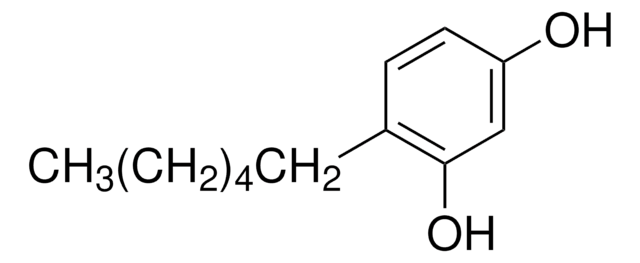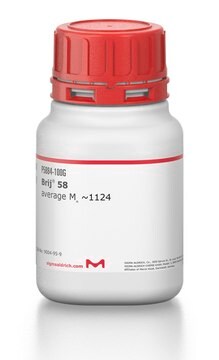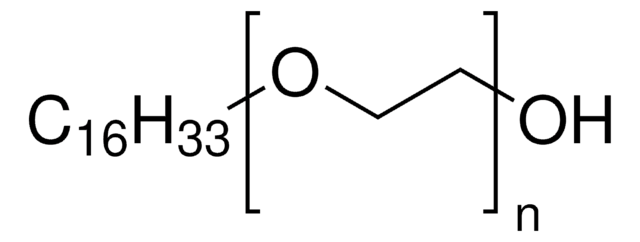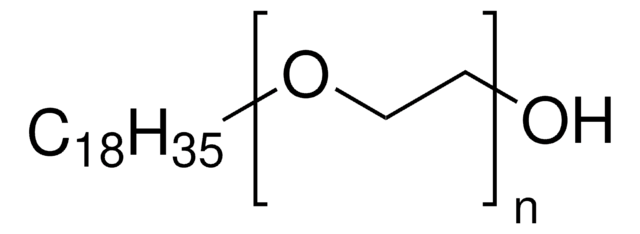추천 제품
설명
non-ionic
Quality Level
분자량
average Mn ~362
refractive index
n20/D 1.451 (lit.)
density
0.95 g/mL at 25 °C (lit.)
HLB
9
SMILES string
CCCCCCCCCCCCOCCOCCOCCOCCO
InChI
1S/C20H42O5/c1-2-3-4-5-6-7-8-9-10-11-13-22-15-17-24-19-20-25-18-16-23-14-12-21/h21H,2-20H2,1H3
InChI key
WPMWEFXCIYCJSA-UHFFFAOYSA-N
유사한 제품을 찾으십니까? 방문 제품 비교 안내
일반 설명
Brij® L4 is a non-ionic surfactant. It comprises an alkyl (C12) tail attached to an oxyethylene headgroup.
애플리케이션
Brij® L4 has been used:
- as a surfactant for the synthesis of copper(I) oxide (Cu2O) spherical nanoparticles using a microemulsion technique
- as a non-ionic surfactant for preparing reverse micelles to synthesize Pt3Co alloy nanoparticles
- as a surfactant to enhance the efficiency of interfacial coupling of hydrophobic materials and to make hydrogel
생화학적/생리학적 작용
Brij® L4 exhibits amphiphilic properties. Brij L4 contains hydrophobic and hydrophilic regions that can form micelles and disperse hydrophobic drugs into the core of micelles. This in turn enhances drug solubility. Brij L4 also elicits a strong inhibitory effect against breast cancer resistance protein (BCRP) mediated drug efflux. It inhibits Taq adsorption better when compared to other commonly used surfactants. Brij L4 supports droplet polymerase chain reaction (PCR) in picoliter reaction volumes at standard Taq concentrations.
법적 정보
Brij is a registered trademark of Croda International PLC
신호어
Warning
유해 및 위험 성명서
Hazard Classifications
Acute Tox. 4 Oral - Aquatic Chronic 2 - Eye Irrit. 2 - Skin Irrit. 2
Storage Class Code
10 - Combustible liquids
WGK
WGK 2
Flash Point (°F)
Not applicable
Flash Point (°C)
Not applicable
개인 보호 장비
dust mask type N95 (US), Eyeshields, Gloves
이미 열람한 고객
Darío Morais et al.
Rhinology, 50(1), 80-86 (2012-04-04)
Hereditary Haemorrhagic Telangiectasia or Rendu-Osler-Weber syndrome is a rare autosomal dominant vascular disease characterized by mucocutaneous and gastrointestinal telangiectases and localized arteriovenous malformations in lung, brain and liver. Epistaxis, due to rupture of telangiectases of the nasal mucosa, is the
N Shadid et al.
The British journal of surgery, 99(8), 1062-1070 (2012-05-26)
New minimally invasive treatment modalities, such as ultrasound-guided foam sclerotherapy (UGFS), are becoming more popular. In a multicentre randomized controlled non-inferiority trial, the effectiveness and costs of UGFS and surgery for treatment of the incompetent great saphenous vein (GSV) were
B McAree et al.
European journal of vascular and endovascular surgery : the official journal of the European Society for Vascular Surgery, 43(6), 721-725 (2012-04-18)
To compare the half-life of STD and polidocanol air-based foams and the damage they inflict upon human great saphenous vein in an in-vitro model. The time for the volume of 3% STD and polidocanol foams to reduce by 10% (T(90))
L Lund et al.
The Journal of urology, 191(5), 1347-1350 (2013-11-23)
We evaluate whether aspiration and sclerosing of hydrocele testis is an effective treatment. Men with symptomatic hydrocele testis were included in this prospective, double-blind, randomized study with polidocanol and placebo. Patients were randomized to active treatment or placebo at the
Alessandro Frullini et al.
Dermatologic surgery : official publication for American Society for Dermatologic Surgery [et al.], 38(5), 741-747 (2012-05-01)
Foam sclerotherapy has been proven to be a safe and effective treatment for superficial venous insufficiency, but transient visual and neurologic disturbances continue to be reported. These side effects have been theorized to be related to the presence of air
자사의 과학자팀은 생명 과학, 재료 과학, 화학 합성, 크로마토그래피, 분석 및 기타 많은 영역을 포함한 모든 과학 분야에 경험이 있습니다..
고객지원팀으로 연락바랍니다.










